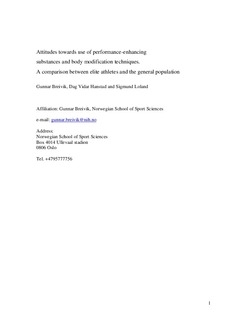| dc.contributor.author | Breivik, Gunnar | |
| dc.contributor.author | Hanstad, Dag Vidar | |
| dc.contributor.author | Loland, Sigmund | |
| dc.date.accessioned | 2010-08-16T11:37:09Z | |
| dc.date.available | 2010-08-16T11:37:09Z | |
| dc.date.issued | 2009-08 | |
| dc.identifier | Seksjon for kultur og samfunn / Department of Cultural and Social Studies | |
| dc.identifier.citation | Sport in Society. 2009, 12(6), 737-754 | en_US |
| dc.identifier.issn | 1743-0437 | |
| dc.identifier.uri | http://hdl.handle.net/11250/170627 | |
| dc.description | I Brage finner du siste tekst-versjon av artikkelen, og den kan inneholde ubetydelige forskjeller fra forlagets pdf-versjon. Forlagets pdf-versjon finner du på www.informaworld.com: http://dx.doi.org/10.1080/17430430902944183 / In Brage you'll find the final text version of the article, and it may contain insignificant differences from the journal's pdf version. The definite version is available at www.informaworld.com: http://dx.doi.org/10.1080/17430430902944183 | en_US |
| dc.description.abstract | Medical and technological developments open up new possibilities for modifying the
body and enhancing performance in various areas of life. This study compares attitudes
among Norwegian elite athletes (n ¼ 234) with attitudes in the general population
(n ¼ 428). Whereas vitamins, nutritional supplements and hypoxic rooms were
accepted by more than 65% of both athletes and population the rejection of EPO,
anabolic steroids and amphetamines were similarly clear in both groups. The athletes
were in general more reluctant to use performance enhancement means and body
modification techniques than the general population. A significantly higher percentage
of the population than the athletes accepted a) means to avoid memory failure in old
age (61.6 versus 43.2, sig. 0.000), b) means to avoid decrease in physical fitness among
old people (48.6 versus 34.7, sig. 0.005), c) liposuction (30.1 versus 12.4, sig. 0.000), d)
surgery for obesity (15.3 versus 9.4, sig. 0.035), e) silicon implants (9.9 versus 5.1, sig.
0.001). The athletes were significantly more satisfied with their bodies than the
population (sig. 0.000). Males were more positive about the use of performance
enhancement means, whereas females were more positive about body modification
techniques. Males were significantly more positive about the use of a) means that
increase strength and endurance (sig. 0.002, and b) means that increase sexual
performance (sig 0.000). Females were significantly more positive than males about the
use of liposuction (sig. 0.000), plastic surgery on the face (sig. 0.013), surgery to
combat obesity (sig. 0.000) and silicon implants (sig. 0.000). | en_US |
| dc.language.iso | eng | en_US |
| dc.publisher | Taylor & Francis | en_US |
| dc.subject | doping | en_US |
| dc.subject | performance-enhancing drugs | en_US |
| dc.subject | plastic surgery | en_US |
| dc.subject | artificial implants | en_US |
| dc.subject | anabolic steroids | en_US |
| dc.subject | amphetamines | en_US |
| dc.subject | liposuction | en_US |
| dc.subject | athletes | en_US |
| dc.title | Attitudes towards use of performance-enhancing substances and body modification techniques : a comparison between elite athletes and the general population | en_US |
| dc.type | Journal article | en_US |
| dc.type | Peer reviewed | en_US |
| dc.subject.nsi | VDP::Social science: 200::Social science in sports: 330::Other subjects within physical education: 339 | en_US |
| dc.source.pagenumber | 737-754 | en_US |
